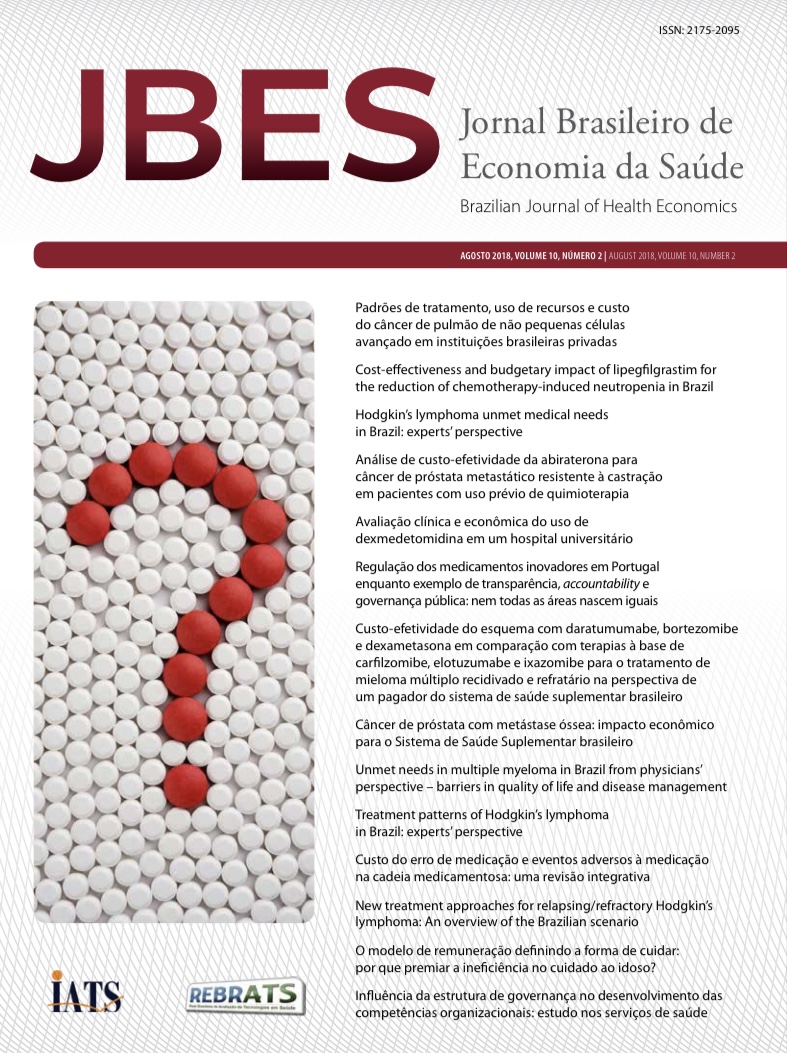Custo-efetividade do esquema com daratumumabe, bortezomibe e dexametasona em comparação com terapias à base de carfilzomibe, elotuzumabe e ixazomibe para o tratamento de mieloma múltiplo recidivado e refratário na perspectiva de um pagador do sistem
DOI:
https://doi.org/10.21115/JBES.v10.n2.p148-156Palavras-chave:
mieloma múltiplo, daratumumabe, carfilzomibe, elotuzumabe, ixazomibe, custo-efetividadeResumo
Objetivo: O objetivo deste estudo é estimar a razão de custo-efetividade incremental da combinação de daratumumabe, bortezomibe e dexametasona (DVd) em comparação com carfilzomibe com dexametasona (Kd); carfilzomibe, lenalidomida e dexametasona (KRd); elotuzumabe, lenalidomida e dexametasona (ERd); e ixazomibe, lenalidomida e dexametasona (IRd) no tratamento do mieloma múltiplo refratário ou recidivado (MMRR) sob a perspectiva de um pagador privado no Brasil. Métodos: Foi utilizado um modelo de transição com três estados, baseado no método de área sob a curva, para simular a trajetória de uma coorte com MMRR: pré-progressão, pós-progressão e morte. Parâmetros clínicos foram obtidos por meio de uma metanálise e os custos incluídos foram aquisição e administração de medicamentos e serviços médicos. O horizonte de tempo adotado foi de 30 anos e descontos de 5% foram aplicados tanto a custos quanto a desfechos de efetividade. Análise de sensibilidade probabilística foi realizada. Resultados: Demonstrou-se que o esquema terapêutico DVd é dominante sobre Kd, KRd, ERd e IRd. DVd gerou 1,09 ano de vida incremental versus Kd com economia de R$ 174.227; 0,15 ano de vida incremental com redução de R$ 238.324 em comparação com KRd; incremento de 0,06 ano de vida com redução de R$ 641.021 comparado com ERd; e 0,59 ano de vida incremental com economia de R$ 254.367 comparado com IRd. A análise de sensibilidade probabilística confirmou a consistência e a robustez do modelo e demonstrou que DVd tem probabilidades de 92,9%, 89,1%, 99,9% e 94,2% de ser custo-efetivo em comparação com Kd, KRd, ERd e IRd, respectivamente, assumindo um limiar de disposição a pagar de 3 PIB per capita. Conclusão: DVd demonstrou ser superior aos comparadores tanto em desfechos clínicos quanto econômicos no tratamento do MMRR, dados a maior sobrevida e os menores custos






